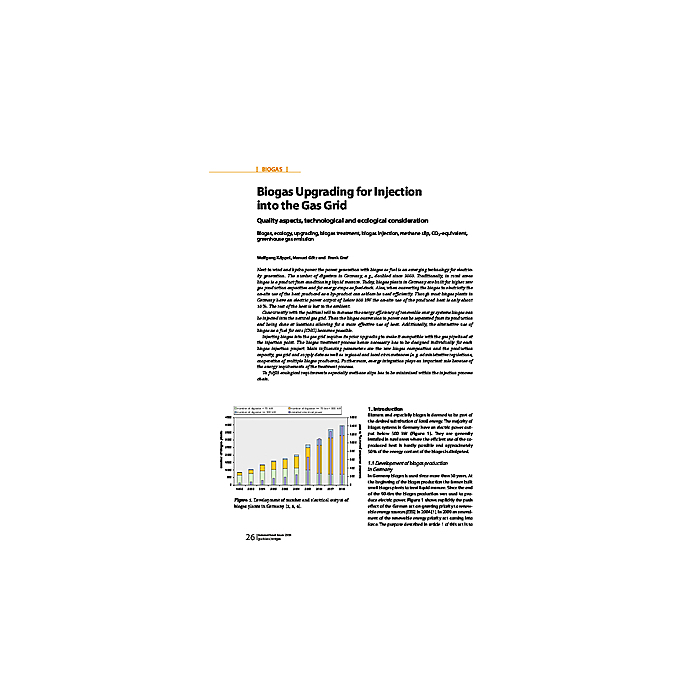Biogas Upgrading for Injection into the Gas Grid
€4.90
In stock
article number
05398_2009_SP1_04
Next to wind and hydro power the power generation with biogas as fuel is an emerging technology for electricity generation. The number of digesters in Germany, e. g., doubled since 2003. Traditionally, in rural areas biogas is a product from conditioning liquid manure. Today, biogas plants in Germany are built for higher raw gas production capacities and for energy crops as feedstock. Alas, when converting the biogas to electricity the on-site use of the heat produced as a by-product can seldom be used efficiently. Though most biogas plants in Germany have an electric power output of below 500 kW the on-site use of the produced heat is only about 10 %. The rest of the heat is lost to the ambient. Concurrently with the political will to increase the energy efficiency of renewable energy systems biogas can be injected into the natural gas grid. Than the biogas conversion to power can be separated from its production and being done at locations allowing for a more effective use of heat. Additionally, the alternative use of biogas as a fuel for cars (CNG) becomes possible. Injecting biogas into the gas grid requires its prior upgrading to make it compatible with the gas pipelined at the injection point. The biogas treatment process hence necessary has to be designed individually for each biogas injection project. Main influencing parameters are the raw biogas composition and the production capacity, gas grid and supply data as well as regional and local circumstances (e. g. administrative regulations, cooperation of multiple biogas producers). Furthermore, energy integration plays an important role because of the energy requirements of the treatment process. To fulfill ecological requirements especially methane slips has to be minimized within the injection process chain.
| Authors | Wolfgang Köppel/Manuel Götz and Frank Graf |
|---|---|
| Publishing Date | 30 Apr 2009 |
| Format | |
| Zeitschrift | gwf - Gas|Erdgas - Special 1 2009 |
| Publisher | DIV Deutscher Industrieverlag GmbH |
| Language | German |
| Pages | 10 |
| Title | Biogas Upgrading for Injection into the Gas Grid |
| Description | Next to wind and hydro power the power generation with biogas as fuel is an emerging technology for electricity generation. The number of digesters in Germany, e. g., doubled since 2003. Traditionally, in rural areas biogas is a product from conditioning liquid manure. Today, biogas plants in Germany are built for higher raw gas production capacities and for energy crops as feedstock. Alas, when converting the biogas to electricity the on-site use of the heat produced as a by-product can seldom be used efficiently. Though most biogas plants in Germany have an electric power output of below 500 kW the on-site use of the produced heat is only about 10 %. The rest of the heat is lost to the ambient. Concurrently with the political will to increase the energy efficiency of renewable energy systems biogas can be injected into the natural gas grid. Than the biogas conversion to power can be separated from its production and being done at locations allowing for a more effective use of heat. Additionally, the alternative use of biogas as a fuel for cars (CNG) becomes possible. Injecting biogas into the gas grid requires its prior upgrading to make it compatible with the gas pipelined at the injection point. The biogas treatment process hence necessary has to be designed individually for each biogas injection project. Main influencing parameters are the raw biogas composition and the production capacity, gas grid and supply data as well as regional and local circumstances (e. g. administrative regulations, cooperation of multiple biogas producers). Furthermore, energy integration plays an important role because of the energy requirements of the treatment process. To fulfill ecological requirements especially methane slips has to be minimized within the injection process chain. |
Write Your Own Review

